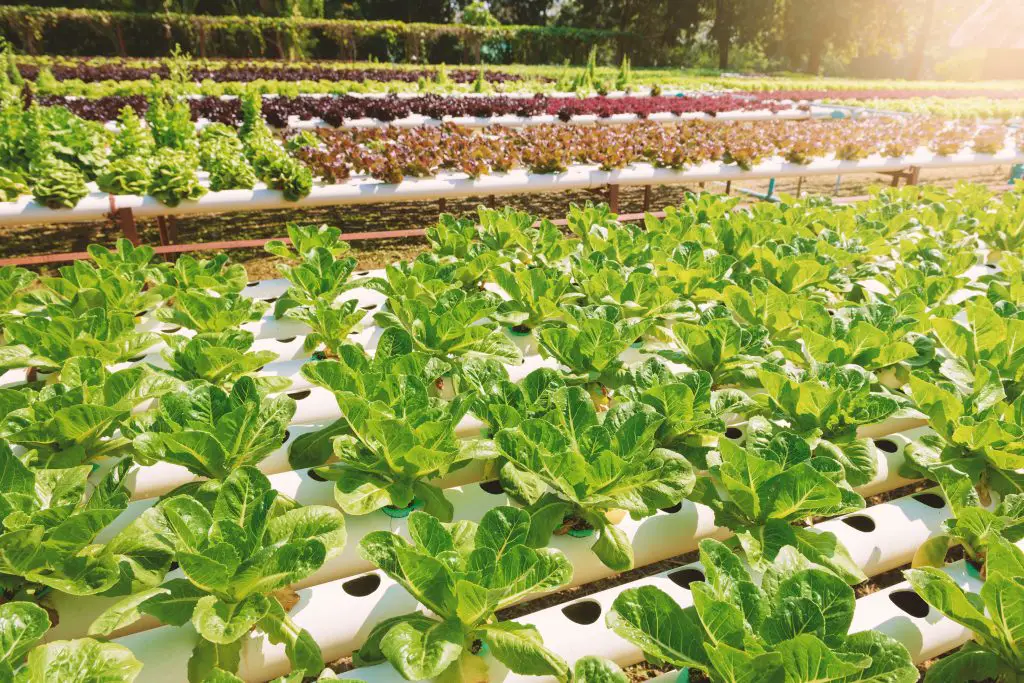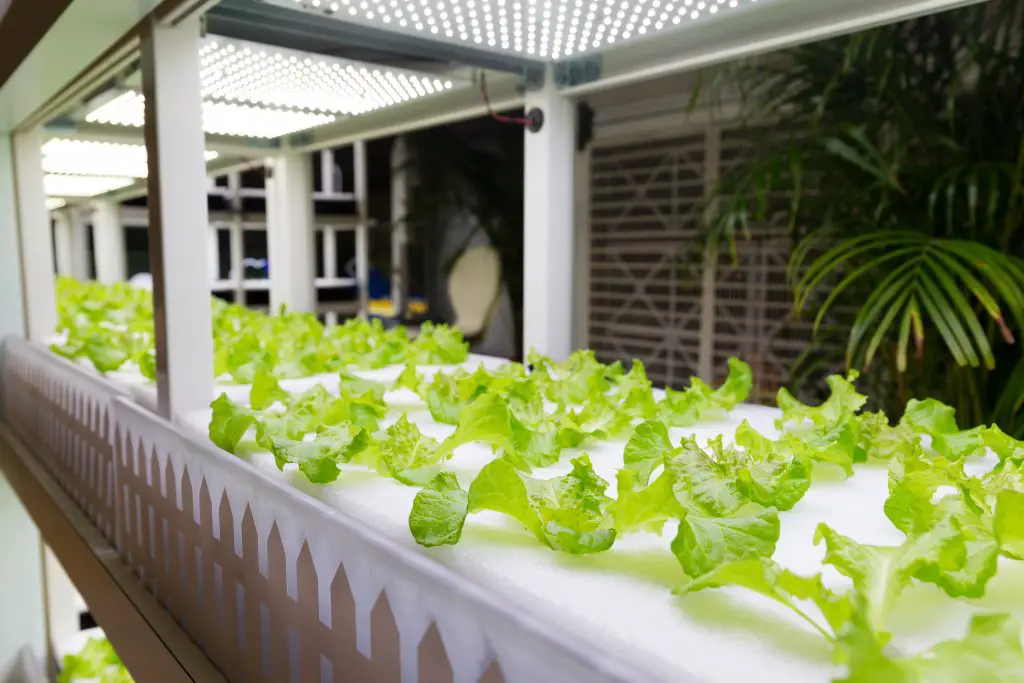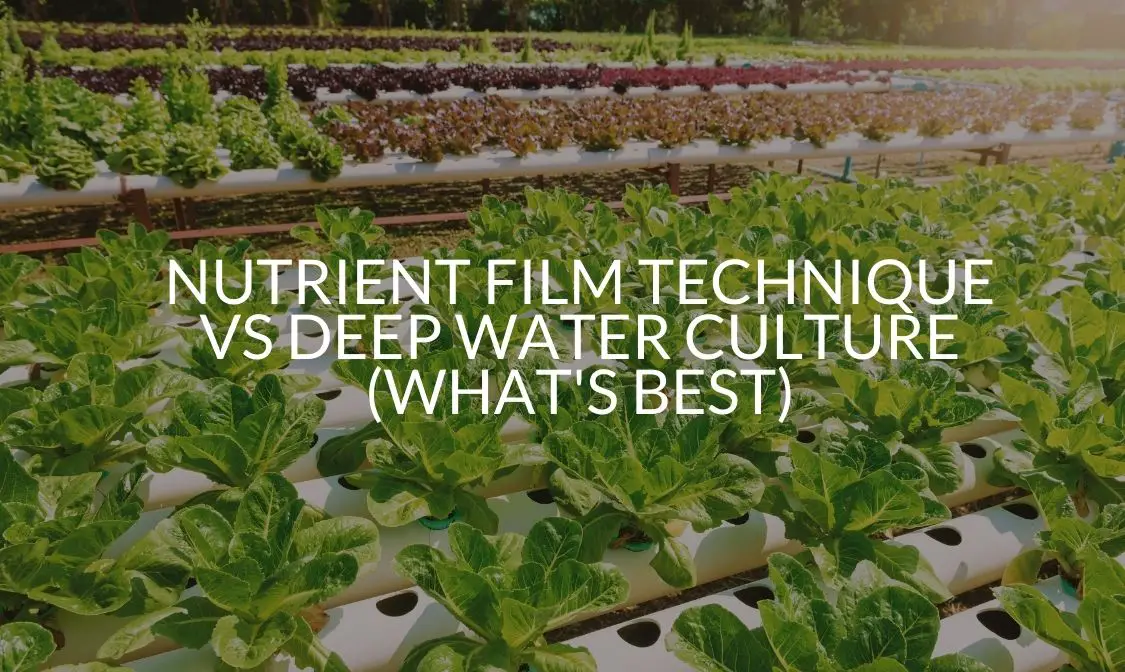There are many hydroponics systems available and there’s a sea of information to wade through in order to understand the differences. The most common ones people ask about are NFT (Nutrient Film Technique) vs. DWC (Deep Water Culture). While both require air pumps, there are nuances to each method that may affect your decision.
Regardless, hydroponics gardening is a great and wonderful way to grow fresh fruits and vegetables. This is invaluable for smaller living quarters or to be able to have produce all year round.
How Does An NFT Setup Work?
NFT, or Nutrient Film Technique is a hydroponics system that relies on water movement to deliver nutrients to plant root systems. This is the least common form of hydroponics but one of the most versatile.
There are long channels, tubes, or gutters that go into a reservoir of nutrient-rich water with a growing tray, net pots, and an air pump. Net pots provide stability for the seedlings while a capillary mat or other absorbent material sits at the bottom of the tray. This ensures a smooth and even flow of water.
Channel Materials
The channels can be silicone or plastic tubes, PVC piping, or a homemade contraption with holes bored throughout it. The nutrient solution flows as a thin film over the roots, nourishing and hydrating the lower parts while the top stays dry. This drier section is what provides excellent access to oxygen through aeration via the air pump.
A Consistent Water Stream
The reservoir connects to the channel via the air pump and goes right into the grow tray. One end of the tubes or channels sits lower than the other, creating a consistent stream at the bottom of the tray.
An air stone rests in the reservoir and connects to an air pump for optimal oxygenation. There’s also a drain pipe that recycles unused nutrients back into the plants which provide a continuous flow of nutrients and water.
Because the system relies on channels rather than trays, the tray angles in a downward position. This helps with nutrient recirculation and ensures they go right into the roots without creating too much waste.
What Are the Pros Of An NFT Setup?
The benefits of having an NFT setup are almost limitless. They’re great for plants with small, shallow roots like herbs, microgreens, and lettuce, or any plant that doesn’t need a lot of support. The plants should be lightweight and fast-growing with the ability for a quick harvest.
No Growing Medium Needed & Little Waste
There’s very little need for a growing medium and not a lot of waste to deal with because of the system’s inherent recirculation. The excellent oxygen flow helps distribute nutrients into the roots, so growing media should be sparing.
You want to ensure an even distribution of nutrients while at the same time guaranteeing aeration. This is the key to the success of an NFT system.
Easy DIY Channels
Anyone can easily build their own channels. Spare PVC piping or using 2x4s and waterproof lining will do the trick. There is no need for automatic timers either. So, you don’t have to spend a lot of money to make one if buying a premade system is outside of your budget.
Space Saver
NFT systems can be very small operations which makes it convenient for those who have a small living space. You can easily put one of these in the kitchen and have your own fresh produce in a matter of weeks.

What Are the Cons Of An NFT Setup?
As with anything, there are some pitfalls to having an NFT hydroponics setup. While the benefits definitely outweigh the detriments, it may affect your decision in having one at home.
Limited Plant Selection
NFT is not capable of handling top-heavy plants or ones with big roots that require massive nutrition. This means things like tomatoes, beets or squash will struggle. NFT can work with these kinds of plants but you have to ensure solid support with trellises or other props.
Not All Roots Touch the Nutrients
During many stages of the growing process, not all the roots touch the nutrients in a desirable way. When you first transplant the seedlings, you have to use a drip system until roots are large enough to reach down into the solution.
Even then, If using PVC piping for the channels, the solution won’t evenly coat the roots. This is because the ones in the middle reach a deeper depth than the shorter ones at the edges, resulting in uneven growth and plant weakness. So, any application of a growing medium must be sparse to ensure the roots touch the solution.
Pump Failures & Clogging
Any kind of pump failure, either from a power outage or the mechanism itself, can completely ruin your crop. What’s more the pump, channels and other parts can clog easily because the roots can overgrow. This blocks the channels which prevent a proper distribution of nutrients, air, and water.
You have to devise a backup plan and have it ready in case of emergencies. Plus, you’ll need to check and trim the roots often to prevent clogging before it can start.
How Does A Deep Water Culture Work?
Another form of hydroponics gardening is Deep Water Culture (DWC). Without using a growing media, the roots encase in a net pot which suspends them in a nutrient solution. “Deep” in this context references the submergence of the roots in water with never-ending oxygenation.
Sufficient Nutrient Uptake
In this type of hydroponics system, the plants are able to absorb oxygen efficiently and sufficiently with a great uptake of nutrients and hydration all day, every day. This makes them grow faster and, in many cases, better than in traditional soil.
Aeration, or getting air into the roots, is the most crucial aspect of a DWC system in order for it to be successful. Once the robust root system establishes, water in the reservoir lowers. This exposes certain parts of the plant’s roots to the air, which then results in the quick development of the plant.
Aeration Options
You can provide aeration in one of two ways: air bubbles or falling water. Whichever one you choose, it has to be constant and consistent or the roots will suffer from root rot. You’ll know when it sets in because they will look dark brown or black. It means your plants are bound to their ultimate demise.
Air Bubbles
Air bubbles come from an electric air pump connected via an airline to an air stone in the reservoir. This is where the nutrient solution sits. The air pump injects oxygen into the reservoir and pushes it through the air stone. This allows the plant to absorb maximum nutrients for accelerated and prolific growth.
The more bubbles, the better it will be for the plants. As the bubbles rise, they make direct contact with the roots to give them plenty of oxygen.
You can also use soaker hoses. These work well to create bubbles and they’re smaller than ones made by air stones. It may actually be better because smaller bubbles give better aeration to the roots. This is due to the fact that there’s more contact with the water and the dissolution of oxygen.
Falling Water
There’s also the option of using falling water. Although not usually an ideal option for home DWC systems, it’s great for larger farming, commercial and industrial operations.
The surface agitation created by the waterfall provides all the needed oxygen for the solution to make contact with the roots. The more force produced by the falling water, the deeper the agitation and thus more dissolved oxygen. But because you’ll use lots of water, expect the cost to be exorbitant.

What Are The Pros Of A Deep Water Culture?
Accelerated growth from the superior uptake of DWC means plants grow faster than they do in soil. Root aeration improves food quality because of this excellent absorption with maximum cell development.
No Fertilizer or Growing Media Needed
There are no growing media or fertilizers required because the solution and aeration provide everything the roots need. They won’t suffocate because they receive air through the nutrient solution along with dissolved oxygen.
Simple, Quick & Easy
This is one of the simplest and easiest hydroponics setups that require little maintenance and there aren’t many moving parts. You won’t have to worry about dealing with clogged water pumps, nozzles, or feeder lines too.
You can harvest crops sooner because growing time is quicker. For instance, you can harvest lettuce in just over a month rather than waiting two months in soil. A variety of plants can grow in a DWC system, including tomatoes, squash, and beets.
What Are The Cons Of A Deep Water Culture?
Smaller-scale operations are vulnerable to over or under-calibration of nutrients which can damage crops and promote malformation.
Air Pump Failures
You only have a short window of time in the event an air pump fails. This can cause your crop to die because the roots will drown from a lack of oxygen.
Water Parameters Are Difficult to Control
Water temperatures are difficult to maintain if using a non-recirculating system. This means they get too hot and can present a problem in the summertime.
Nutrient levels fluctuate and become imbalanced easily too. If you have a system with multiple buckets, you have to test each one. This means regular checking will be imperative and you have to be meticulous about the conditions.
When Should You Use Kratky and When Should You Use Deep Water Culture?
The Kratky Method (KM) is basically another variation of DWC. This is great for newcomers to hydroponics. But, it’s important to understand the differences between the two and there are very few plants that can grow successfully with this. So, only use this method for plants with short growing periods.
It’s a Passive, Inexpensive System
KM is a passive system that doesn’t require a lot of money. It neither needs electricity and air pumps nor does it require other mechanical equipment. You can make your own out of plastic trays that can fit inside one another.
You just plant the seedlings, put them beside a window for light, and leave it alone. You don’t have to flush the system or spend precious time consistently checking solution levels. You will have to check the solution occasionally, but not nearly as much as with a DWC.
Air Gaps Are Important
The key is leaving an air gap between the surface of the solution and the roots so only part of the roots sit in the water while other parts receive airflow. The roots simply need to suspend in the nutrient solution so it develops properly.
As they grow, the nutrient solution level lowers and this creates the air gap. As a result, air roots develop which removes the need for mechanical aeration and a hefty electric bill.
Hassle Free
KM doesn’t need airflow in the same way as a DWC system. As a matter of fact, you don’t have to fuss over or check it as often. Once you put it in its spot, you leave it there and peek at things once a week.
Recap
There are many benefits of a hydroponics system. Food grows faster and it doesn’t take up a lot of space. Plus, they’re often inexpensive and the initial investment doesn’t require a lot of money.
When considering using an NFT or DWC system, the main difference is how you aerate the roots. An NFT needs a constant stream of water via an air pump and with DWC, an air bubbler procure from an air stone connected to an air pump.
But, if you want to get your feet wet because you’re new to hydroponics gardening, try the Kratky Method first to see how it goes for you. Although you’ll have to start with something small, you’ll get a feel for how it all works and how you like it.



